Sunday, March 16, 2008
Real Density Comparisons
Saturday, March 15, 2008
Why Are We Giving People Money?
A national infrastructure program. That is spending on alternative energy infrastructure and massive transit upgrades. This would do two things as Jerome states so well:
...provide a real boost to the economy in the sectors that actually need it, would reduce oil&gas consumption and carbon emissions, and be an actual investment in the future, as opposed to the current drain on the future that's been engineered via debt used on mindless consumption of junk.It would sure beat everyone getting $600 dollars to spend on goods made overseas. But what makes this a better investment? Recently a report from the Institute of Policy Studies came out that discussed the jobs created in the defense industry versus other key sectors that need investment. Spending on education and transit created far more jobs than defense. Transit was the highest job creator and created predominantly middle class jobs with incomes between $32-$64k. I would imagine greater increases in spending for transit would generate even more jobs as there are needs for manufacturing when demand is created.
 (H/T Free Public Transit Blog)
(H/T Free Public Transit Blog)Thursday, March 13, 2008
More Research and Reports
People living in households near public transit travel 12 fewer miles per day which is 27 percent less than persons in households with no access to public transit according to the study. This equates to an individual household reduction of 223 gallons of gasoline a year.Smart Growth America - Growing Cooler
They warn that if sprawling development continues to fuel growth in driving, the projected 59 percent increase in the total miles driven between 2005 and 2030 will overwhelm expected gains from vehicle efficiency and low-carbon fuels. Even if the most stringent fuel-efficiency proposals under consideration are enacted, notes co-author Steve Winkelman, “vehicle emissions still would be 40 percent above 1990 levels in 2030 – entirely off-track from reductions of 60-80 percent below 1990 levels by 2050 required for climate protection.“Department of Homeland Security - Transit Threat Assessment
The Greenness of Cities - Edward Glaeser
Over the past 50 years, automobile oriented suburbs have grown much more quickly than denser urban areas, and over the past six years, the four fastest growing American metropolitan areas have been Atlanta, Dallas, Houston and Phoenix—all hot places that use an impressive amount of electricity to create a pleasant year-round climate. Cars and air conditioners both lead to signifi cant emissions of carbon dioxide, which an increasing body of evidence has linked to potentially dangerous climate change. If this evidence is correct, then there are serious social costs associated with new forms of development that tend to be extremely energy intensive.
It's Space Race Time, and LA is Rockin!
From Curbed LA:
Strategic Unfunded Projects
Tier 1: Currently Under Planning or Environmentally Cleared/Route Refinement Study-Regional Connector
-Metro Subway Westside Extension to La Cienega
-Harbor Subdivision Alternate Rail Technology between LA Union Station and Metro Green Line Aviation Station
-Metro Subway Westside Extension to City of Santa Monica
-Burbank/Glendale Light Rail from LA Union Station to Burbank Metrolink Station
-Metro Gold Line Eastside Extenstion from Atlantic/Pomona Station to City of Whittier
-Metro Gold Line Foothill Extension from Sierra Madre Villa Station to Azusa
-Metro Green Line Extension from Redondo Beach Station to South Bay Galleria
-Metro Gold Line Extension from Sierra Madre Villa Station to Montclair
-Metro Green Line Foothill Extension between Norwalk Station and Norwalk Metrolink Station
-Mero Green Line Extension to LAX
-West Santa Ana Branch ROW Corridor Maglev between LA Union Station and Santa Ana Metrolink StationTier 2
-Metro Red Line Extension from North Hollywood Station to Burbank Airport Metrolink Station
-Vermont Corridor Subway
-"Yellow" Line Light Rail between Metro Red Line North Hollywood Station and Regional Connector
-I-405 Corridor Busway between Metro Orange Line Sepulveda Station and Metro Green Line Aviation Station
-"Silver" Line Light Rail between Metro Red Line Vermont/Santa Monica Station and City of La Puente
-Metro Green Line Extension from LAX to Expo Santa Monica Station
-SR-134 Transit Corridor Bus Rapid Transit between Metro Red Line North Hollywood Station and Metro Gold Line Del Mar Station
-Metro Green Line Extension between South Bay Galleria and Pacific Coast Hwy Harbor Transitway Station

Wednesday, March 12, 2008
Why Are the Goal Posts Moving?
I wouldn't have a problem with this if the FTA had more money and was likely to fund more projects. But they don't and they aren't. In fact lately they have been tightening the screws. This year had the least number of projects in the new starts process than any year previous. In the late 90s there were usually around 40 projects in Preliminary Engineering. Today there are 10. Yes 10 projects. Out of all the planned projects (At least 50) that I've listed in the Transit Space Race for expansion in the United States, there are only 10 projects in preliminary engineering. Administrator Simpson claims that the Bush administration has funded more projects than during Clinton, but we know that most of these projects were started during the 90s and they are only now able to start shutting off the money with Secretary Peters at the helm.
This is a direct result of the Bush administration's disdain for transit. And while its likely to get better with a new administration, there is going to be a big fight for the new transportation bill to see where money goes in 2009. The Mary Peters set including Wendell Cox and Ken Orski are saying that there is no need for new rail starts in the United States. They say the rail expansion is over and right now they have the ears of the politicos at the FTA.
Which brings me to Seattle. The Sierra Club all over the United States has really fried my bacon, with the exception of Boston. Those guys are doing a great job, but here in Marin and up in Seattle they don't get it. In Marin like Seattle, the SC is lobbying against the train because it will bring growth. It's coming whether you like it or not. You can let all those people drive all the way into town or you can build a line that allows for TOD and expansion of transit PMT. But in addition, whether you like it or not, parking is big in the FTA models I discussed above which are a large part of the cost effectiveness measure. In fact, I would wager that if the Sierra Club got its wish, there would be no federal money for the extensions in Seattle and the lines would be funded completely by local taxes. I'm not sure that would sit well with folks up there. There are better ways to control growth than not building an important transit line.
Tuesday, March 11, 2008
Parking Lot Congestion Pricing?
But what about a rush hour parking tax?
Parking garages have meters that do timestamping, so why not charge a fee for parking between 8:00 and 9:30 and leaving between 4:30 and 6:00. When you use that funding for expanding transit, you can then expand to road based congestion pricing after expanding transit. That way if you don't have any other options, you can still get in and park if its early or late making people vary their timing surely making it more equitable. I'm sure there are drawbacks because this just popped into my head and I didn't think it through completely but I'd like to hear people's take on it. It could be too limited to workers downtown for instance. Or people could just write it off on their taxes unless that benefit was taken away.
"Auckland, One of the Most Auto Dependent Cities in the World"
Part 1. City of Cars
Part 2. It's Too Spread Out for Transit
Part 3. Sustainable Transport is Uneconomic
Monday, March 10, 2008
U.S. Transit Takes 10.3 Billion Trips in 2007
For comparison to the much touted 10 Billion number that we've had the last two years consider this, Budapest (my favorite transit city) residents took over 1.4 Billion trips in 2003 in a region of 2.4 million people. The population of the United States is around 300 Million. While there are obvious differences in urban form and the availability of transit there versus here, its telling of what is possible if we design transport systems correctly and design our neighborhoods accordingly.
For a better western example that wasn't over run by communism until 1989, Vienna (A metro of 2.2 million) takes 700 Million annual trips. The tram network carries 280,000 passengers a day. The U Bahn metro carried 427 million trips in 2005. They began building their metro system in the 60s and finished in 1982. While they had a legacy street railways network, that can be done in time as well.
It's possible for us to catch up, but we gotta start moving a little faster. If each of the top 50 metro regions can get 700 million trips per year, we can increase ridership to 35 Billion trips. Is that possible? I don't know, I'm just tossing out numbers, but it would be amazing and would do a lot for the environment and create jobs.
I also love a good reason to use pictures from my trip last fall. The one below is a tram loop on the Ringstrasse in Vienna.

Sunday, March 9, 2008
Dolores Park Blogging
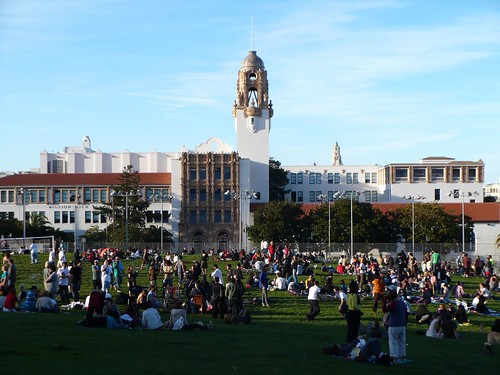
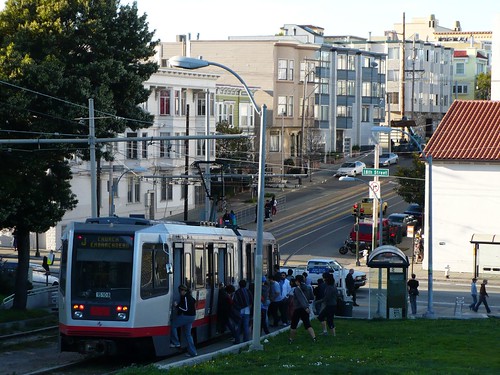
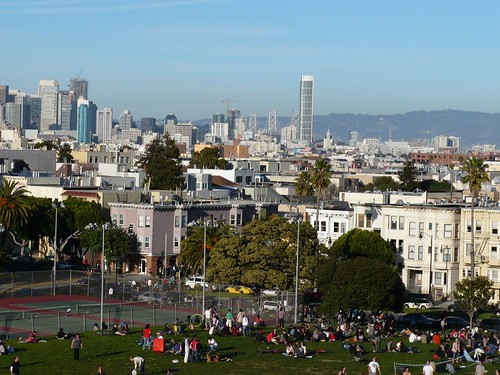
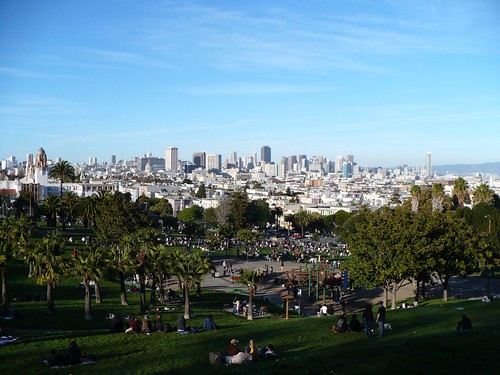
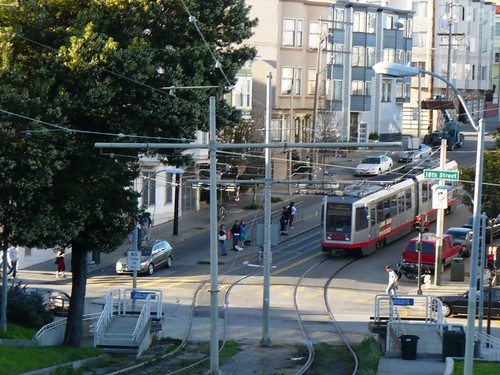

US PIRG Releases Transit Report

A few other pieces of information from the report:
Carbon dioxide from our automobiles equals the total emissions from Germany, Japan and Canada.
Commercial Parking lots in this country cover more space than the state of Delaware.
Rail saves a lot of oil with heavy rail systems like the subways in New York and Washington DC doing most of the heavy lifting. The chart below shows oil savings from LRT.
 Transit provides a wide range of benefits including, reduced road expenditures, reduced cost from traffic accidents and reduced public and private costs to providing parking.
Transit provides a wide range of benefits including, reduced road expenditures, reduced cost from traffic accidents and reduced public and private costs to providing parking.Investments in transit create 19% more jobs than equivalent investments in roads.
In 2005, the subsidy to highways was $39 billion dollars.
In 2005, the state expenditure on highways was $100 B dollars. Transit was $7.8B
And many more...
At the end of the report PIRG advocates that we stop spending money on new highways and shift to building more transit. The Interstate Highway Program has funded all of the necessary highways in this country and its time to fill the gap between what was neglected in the last half of the 2oth century.
